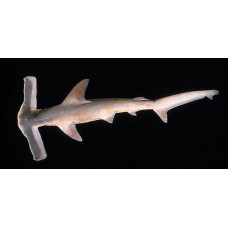Latin name
Eusphyra blochii
Other names
Eusphyra blochii
Identification
Very long and narrow lateral growths on the sides of the head distinguish this shark from all other species. The width of the "hammer" is 40-50% of the body length, there are small notches in the front part of the nose, the protrusions have the shape of a wing when viewed from above. Unlike Sphyrna, the nostrils are closer to the center of the "hammer" than to the ends, and there are large lateral projections that almost reach the eyes.
The lateral growths on the head are so large that they appear bulky. The nostrils and ampullae of Lorenzini are wider than those of other sharks in the genus. These characteristics suggest that the anatomy of this species originally evolved to emphasize sensory rather than hydrodynamic functions.
Features of fish fins
Dorsal spines (total): 0; Dorsal soft rays (total): 0; Anal spines: 0; Anal soft rays: 0.
Fish colouring
The coloration is gray or gray-brown, the belly paler.
Distribution
Inhabit the Indo-West Pacific: from the Persian Gulf to the Philippines, north to China, south to Australia.
Habitat
A tropical marine brackish water benthic benthopelagic amphidromous species.
Size
It is a small shark measuring no more than 1.86 meters.
Behavior
Occurs in shallow waters on continental and island shelves. It enters river mouths.
Food and feeding habits
They feed mainly on small bony fish, crustaceans and cephalopods.
Reproduction
They are viviparous; developing embryos are nourished by a placental connection to the mother formed by an empty yolk sac. Off the coast of Bombay, pups are born just before the rainy season in April and May, and mating occurs during the monsoon season from June to August. Pregnancy lasts eight months. Off the coast of Australia, females give birth in February and March and the pregnancy lasts 10 to 11 months. A litter contains from 6 to 25 offspring. Newborns range in size from 32 to 45 centimeters. Females give birth annually. Sexual maturity occurs at a length of 110 cm.
Fishing
No threat to humans. This species is fished in India, Pakistan, Malaysia and Thailand and probably in other parts of its range. It is caught with floating and bottom gill nets, longlines, and probably by hooking. These sharks are often caught in nets off the coast of Kalimantan.
Relationship with a person
The meat is used for food, the liver for vitamins and the carcass for fish meal.
Interesting facts
Winghead sharks have eyes at either end of a hammer-like growth. This is no coincidence as they often prey on stingrays. Some stingrays have spikes on their tails and if the Winghead sharks eyes were positioned differently, they could easily be injured.
| Classification | |
| Phylum | Chordata |
| Class | Chondrichthyes |
| Squad | Carcharhiniformes |
| Family | Sphyrnidae |
| Genus | Eusphyra |
| Species | E. blochii |
| Features | |
| Conservation status | Endangered |
| Habitat | Pelagic |
| Life span, years | No information |
| Maximum body weight, kg | No information |
| Maximum length, cm | 186 |
| Sailing speed, m/s | No information |
| Threat to people | Edible |
| Way of eating | Predator |
Winghead shark
Tags: winghead shark



